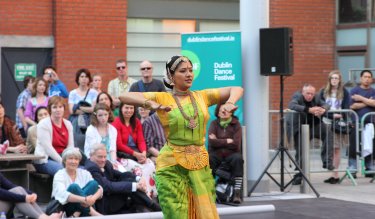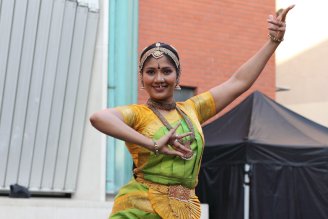
|   |

|   |
Classic(al) triumph Photos: Sam Abraham, Ireland July 27, 2012 Successfully striding its eighth year, the Dublin Dance Festival (DDF) 2012 is one of Europe's most prestigious festivals dedicated to dance in its full glory. Beginning in 2002 as a biannual program originally, it has now become an annual affair attracting artistes from all over the world. This year's festival programmed by Julia Carruthers, a renowned name in the world of UK dance scenario, provided an exciting range of artistes from over seventeen countries showcasing dance and its movements from the perspectives of ‘at home’ and ‘the world.’ Spread over two weeks (11- 26 May 2012), this year's festival drew house-full audiences in almost all of its performance spaces that were spread out in the Irish city of Dublin. Concentrated in and around the centre of the city, the festival was a joy, what with even DDF food coupons being made available to those hopping from one venue to the other - an interesting idea for Chennaites during the December season! The festival opened with Trisha Brown Company from the US and ended with our very own Bharatanatyam and a theatre play titled ‘Blue Boy.’ Amongst the 34 performances and 3 symposiums encompassing countries such as USA, UK, Norway, France, Spain, Ireland, Germany, South Korea, Latvia, Russia and Austria, India was represented by Divya Kasturi presenting the two most popular South Asian dance styles of the UK - Bharatanatyam and Kathak. 

Divya Kasturi, now with dual homes at Chennai and UK, showcased two flavours of the dance form - Darshan, a classical piece followed by her recent contemporary production NowHere, which she toured in the UK funded by the England Arts Council. The two pieces are contrasting in their presentation, conceptualisation and aesthetics, the common thread amongst them being the Bharatanatyam foundation vividly articulated in both the pieces. Darshan was first tested as a short teaser in the annual festival of International Dance Alliance in Chennai. Kasturi expanded the piece redesigning and contextualising the concept with the theory of Darshan, put forward by Professor Diana Eck of Harward University. Exploiting ideas of visualising the divine through an epiphanic moment highlighted by unique lighting design, Darshan enthralled the Irish audiences. Adi Shankaracharya's five verses on Lord Shiva were interspersed with complicated movement patterns composed by her guru Udupi Laxminarayana. In contrast, NowHere is a contemporary production wherein Kasturi interweaves Western contemporary dance techniques with Bharatanatyam and Kathak incorporating a specially composed music and visual projection design by well known London based composer John Marc Gowans. Themed on a concept widely frequented by many artistes, Kasturi's take on identity witnessed a refreshing movement language brought out through her skills assimilated from her experience in the UK dance and theatre worlds. The narrative of belonging 'there' and 'here' at once, was achieved through the use of video design that expressed notions of memory, delay, overlap, one and many in addition to visuals from Chennai and London portrayed as the two space / place of activity. The performance was on for two nights at the historical space of the Abbey theatre in its smaller intimate theatre space Peacock followed by a post performance talk with Divya Kasturi and John Marc Gowans. The more than 90% audiences on the first night was followed by a nearly sold out show on the second night, leading onto an extra performance on the third day - an outdoor performance. Organised at Dublin's famous meeting point at Temple Bar, India's much celebrated Bharatanatyam was witnessed by more than five hundred people, some Indian faces too, who hurried to say later on that “the Irish waft of wind blew along familiar sounds and words to us strolling on the other side …and we rushed here to immerse ourselves and enjoy our own Bharatanatyam in all its essence and glory.” The joy of dancing outside in an open space, with a proper dance floor put in place by the efficient Dublin Dance Festival team in a matter of just sixty minutes, blending in with nature, an open sky that surprisingly did not pour down, what with the famous Irish weather reputation… what more could a performer ask for! |